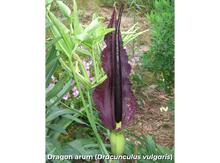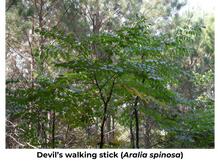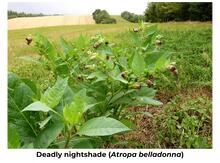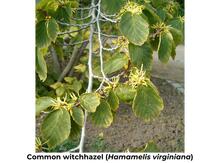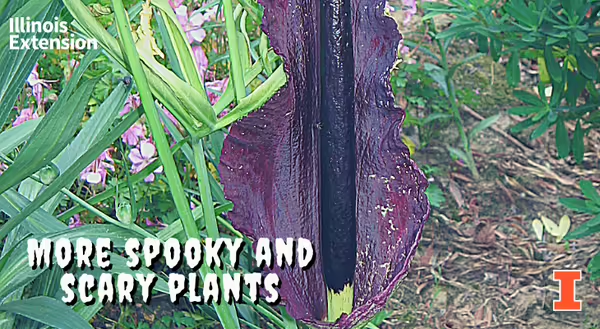
It’s Halloween time again! Last year we had the inaugural list of Spooky and Scary Plants. While trick-or-treating and Halloween parties may look a little different this year, here are some more ‘spooky and scary’ plants to help you get in the Halloween spirit.
Dragon arum (Dracunculus vulgaris) is a scary sounding plant that is native to southeastern Europe (Balkans). It is one of only two species of plants in its genus, Dracunculus, which is one way it gets its common name (Latin for small dragon). Looking at the leaves of these plants, you can also see how it got its name. Each leaf has 9-15 finger-like lobes that are said to resemble the claws of a dragon. Others say the name is in reference to fang-like spadix (flower) the plants will produce. These flowers (actually the spathe) can be 20 inches tall and 8 inches wide. The spathes are maroon-purple in color, and if you know much about pollinator syndromes, you know what that means. The plants are fly pollinated and smell horrible, similar to rotten meat.
If you want to try your hand at growing these scary-sounding and smelling plants, they grow best in well-drained soils in full sun. They may not be reliably hardy in many parts of Illinois, so find a warm microclimate (probably not close to your front door or windows) or dig the bulbs in the fall and overwinter them indoors.
With a name like Devil’s walking stick (Aralia spinosa), you know there’s something scary about these plants. They get their name because their stems, branches, and leaf stalks are covered in stout, sharp spines. Due to its spines, it is resistant to damage from deer. So, if you have issues with deer, this may be a plant for you!
In addition to their spines, another interesting feature of these plants is their leaves. Their compound leaves are 2-5 feet long and 2-4 feet wide, with the individual leaflets being 2-4 inches long, making them the largest leaves in North America!
Devil’s walking stick does best in well-drained soils in full sun to part shade. They typically grow as a suckering shrub that will reach 10-25 feet tall but may occasionally grow as a tree, reaching 35 feet tall. They produce large panicles (up to 2 feet long) of flowers in the summer that are very attractive to bees. Additionally, the resulting black fruit is very attractive to birds.
Deadly nightshade (Atropa belladonna), also known as Devil’s cherries and belladonna, are incredibly poisonous plants. All parts of these plants are toxic (contain tropane alkaloids such as atropine, scopolamine, and hyoscyamine). Symptoms of poisoning include rapid heartbeat, dilated pupils, delirium, vomiting, hallucinations, and death due to respiratory failure.
The berries of these plants are purplish-black and sweet, making them a tempting food source. However, as few as two berries can kill a child; ten berries are often enough to kill an adult. Handling plants can also cause problems, as the toxins can be absorbed through the skin and cause severe dermatitis. There is a long history of using these plants to dispatch one’s foes. It was also believed to be used by witches to help them fly.
There are some redeeming qualities of these plants, though. According to the U.S. Forest Service: “Ophthalmologists use atropine to dilate their patient’s pupils for eye-exams and surgery. Atropine is also used as an antidote to opium and chloroform poisoning. Various preparations of belladonna are used as lotions, plasters, and salves to relieve pain from sciatica, gout, and cardiac palpitations.”
Unlike these other plants, the only scary thing about common witchhazel (Hamamelis virginiana) is its name. In fact, its name has nothing to do with witches. The witch in witch hazel comes from the Anglo-Saxon word wyche, which means pliant or bendable. This is likely because their branches were commonly used as dowsing rods by Native Americans and European settlers.
Common witchhazel is native to eastern North America, including Illinois. It grows as a shrub or small tree that typically grows 15-20 feet tall. Their arching branches will produce bright yellow, fragrant flowers with strap-like petals starting in late October, making them one of the latest blooming plants. These trees are easily grown in a wide range of soils in full sun to part shade.
Good Growing fact of the week: Giant hogweed (Heracleum mantegazzianum) is truly a scary plant. This member of the carrot family can grow 15-20 feet tall and has dangerous sap. The sap can cause severe skin and eye irritation, painful blistering, permanent scarring, and blindness when exposed to sunlight.
Want to get notified when new Good Growing posts are available? SIGN UP HERE!
Dragon arum (Dracunculus vulgaris) photo by Meneerke Bloem, CC BY-SA 3.0. Devil’s walking stick (Aralia spinosa) photo by David Stephens, Bugwood.org. Deadly nightshade (Atropa belladonna) photo by Jan Samanek, Phytosanitary Administration, Bugwood.org. Common Witchhazel (Hamamelis virginiana) photo CC BY-SA 3.0, commons.wikimedia.org.
MEET THE AUTHOR
Ken Johnson is a Horticulture Educator with University of Illinois Extension, serving Calhoun, Cass, Greene, Morgan, and Scott counties since 2013. Ken provides horticulture programming with an emphasis on fruit and vegetable production, pest management, and beneficial insects. Through his programming, he aims to increase backyard food production and foster a greater appreciation of insects.
